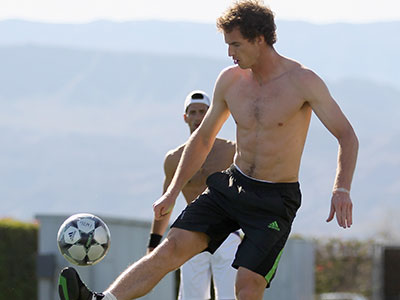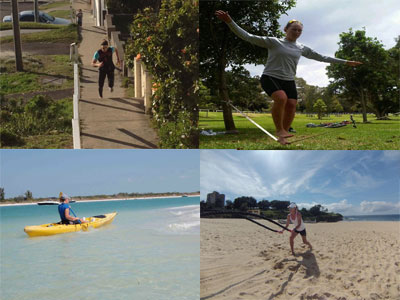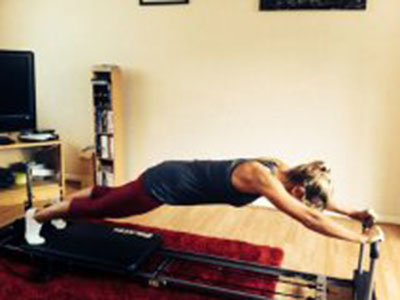With the festive period just around the corner, 19-time ITF Pro-Circuit winner Jade Windley has taken time off from her busy rehab schedule to highlight how important a time December is for a professional tennis player.
Wimbledon 2013 competitor Jade, 24, from Lincolnshire, is currently on the treatment table after suffering a back injury that stopped her in her tracks soon after achieving career high world rankings in April 2014 of 279 WTA singles and 159 WTA doubles.
ONWARDS AND UPWARDS IN OFF-SEASON
If you are a professional tennis player, it’s that time of year again! No, not Christmas party season but off-season. Although the 2014 competitive tennis period has drawn to a close, rest time for players is somewhat limited.
Of course, many will initially take a small break or holiday in order to relax and recharge the batteries and it is imperative they utilise this period of recovery.
Once these few days are over though, it is straight back into training ready for the long competitive campaign ahead which begins in early January. Out of all the sports, professional tennis has one of the shortest off-seasons with the top players at times only having December where they are not scheduled to play any competitive tournaments.
However, this small window is the ideal time for players to make improvements to their game. For the first couple of weeks, players tend to focus on improving physically. They might build muscle, strengthen core stability or develop a strong aerobic base.
Then, as the off-season nears completion, players tend to spend more hours on the court with match practises and exhibitions, in preparation for the tournaments ahead.
 Andy Murray by Getty Images
Andy Murray by Getty Images
ANDY MURRAY’S DEDICATION (Follow Andy in his off-season here)
Tennis is an all-round sport which requires a vast variety of movements so the off-season provides the perfect opportunity to improve in all physical areas. Different players approach their off-seasons in different ways. Andy Murray makes his way across the pond to America every winter to undergo a tough physical training block under the scorching Miami heat.
His boot-camp style training involves beach runs and 400m sprint intervals in radiating temperatures. He is also a fan of Bikram yoga, where the studio can reach a sweltering 43 degrees; an effective way to improve flexibility and focus.
Upper-body and core strengthening are also prime focal points for Murray, with a punishing weighted chin-up routine being a tiresome technique behind those washboard abdominal muscles. Murray endures up to six hours of this gruelling training every day over the five-week period. It is not a coincidence he has consistently delivered at the Australian Open, having made the final three times in the past five years.
 Training methods used by Sam Stosur
Training methods used by Sam Stosur
SAM STOSUR'S VARIATION (Keep up to date with Sam here)
Former Grand Slam Champion and Australian No.1 Sam Stosur enjoys a varied approach to her off-season. She mixes things up by going paddle-boarding, kayaking, swimming, stair running, indoor rock-climbing and boxing. All of these different exercises are clearly working for the former world No.4 as she possesses arms and abdominal muscles that Arnold Schwarzenegger would be proud of.
AND WHAT ABOUT ME? (Follow me here)
Unfortunately, I have been sidelined from competition since July with quite a serious lower back injury. Last week, I was given facet joint injections, which are essentially two large needles being inserted either side of the spine in order to reduce inflammation and help with the healing process. Imagine a lead balloon being pumped into your back and that was the pain that I was feeling!
I am currently unsure of the length of time I will be away from the court as I may require further treatment depending on how I respond to the injections. It is very frustrating to miss the off-season, as this is the one time of year where a tennis player can make huge physical gains over a concentrated training block.
 Jade undertaking a superman plank routine on a reformer machine
Jade undertaking a superman plank routine on a reformer machine
However, I have faced tough injuries in the past and have come out even stronger on the other side, so I am trying to focus on what I am able to do rather than the limitations. I am becoming somewhat of a Pilates expert and have even loaned a reformer machine to aid my core stability even more.
I have to avoid heavy impact exercises, such as explosive jumping and running, which is tough as I have always been a fast mover and struggle to sit still, but I can still maintain my cardio through swimming and short bursts on the spin bike. I have a regimental flexibility and core strengthening routine and the foam roller never leaves my side.
Thanks for reading my article and I hope to be back playing again soon!